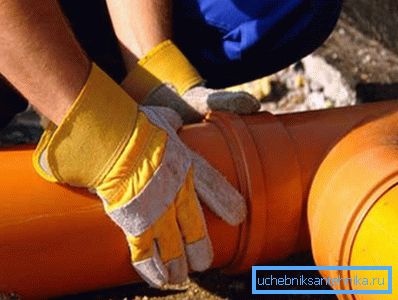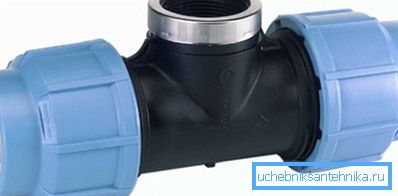How to make the installation of plastic pipes do it
Not long ago, only steel parts were used for arranging heating and running water in an apartment and a private house. But lately, they have been replaced by polymeric materials everywhere, as the installation of plastic pipes with their own hands is less laborious and faster. Let us dwell in more detail on the most common technologies for connecting individual elements of the pipeline with each other.

Types of compounds
Before you install plastic pipes, you must select the type of connection used. A suitable technology depends primarily on the type of polymer composition used.
In the overwhelming majority of cases, water transport networks are mounted:
- Using welding. This requires a special tool for plastic pipes - the so-called soldering iron or "iron". It is used to heat the ends of plastic parts, which are then inserted into each other and welded, forming a sealed unit.
It is possible to connect pipes both with the use of fittings and without them. However, in the latter case, for the arrangement of turns should be used plastic bypass for pipes.
- With the help of adhesive composition. The result is also a permanent connection, but the use of glue eliminates the need for heating. This makes installation easier, but chemicals released during operation have a negative impact on human health and the environment.
- Using threaded fittings. So usually made of plastic pipes of large diameter. In addition, this is one of the ways to get a plug connection. For work you need only wrenches.
- Flame method. In this case, you do not need to know how to cook plastic pipes. The technology is widely used in the installation of internal and external free-flow sewage systems. Allows you to increase the speed of installation, as well as to avoid distortion of the system during linear temperature distortions.

Tip! When using the socket method, a lubricant may also be used for the installation of plastic pipes. Special silicone compound provides additional sealing and prolongs the life of the rubber seals.
The order of docking elements
Before you change the pipes for plastic, you should choose the type of polymer parts used. For independent work it is recommended to use parts from polyvinyl chloride.
They have the following advantages:
- do not corrode;
- resistant to chemical attack;
- tolerate temperature fluctuations well;
- withstand considerable pressure;
- quickly and easily mounted in a single network.
Method 1. Bonding
Do-it-yourself installation of plastic pipes using gluing is done in the following sequence:
- First of all, the acquired pipe is laid out into segments of the desired length, after which they are cut. To do this, use a special pipe cutter or saw for plastic pipes.

- After that, the end is processed. It is necessary to completely clean it from burrs and remove the chamfer from the outside. This will allow the parts to enter the fitting smoothly and effortlessly without removing the adhesive. For this purpose, it is best to use a manual plastic picker for plastic pipes, but you can use a file or a knife.

- At the end of the machining, a cleaning composition is applied to the end face. It degreases and softens the plastic, improving its adhesion properties.
- Check how the pipe enters the fitting. If it is too loose, the connection can let water through, otherwise the adhesive composition can be peeled off. Then in the center of the pipe is a notch. It will be needed later to facilitate installation.
Tip! When buying materials, you should stock up with a little more than necessary number of fittings (especially since their price is low). In this case, if necessary, you can replace one part with another, higher quality.
- Then an adhesive composition is applied to the joint. The pipe needs to be covered with a uniform thick layer, and the inner surface of the fitting is only slightly lubricated. It is necessary to use only the substance that is recommended by the manufacturer of the parts you purchased.

- As soon as the glue is applied, we insert the parts into each other, otherwise the glue will have time to harden. After insertion, the pipe rotates 90 degrees. It will help determine the previously made notch. Then you need to fix the fitting for another 15 seconds for final drying.
If the indoor temperature is below + 20 degrees Celsius, the gluing time is doubled. Speaking at the end of the glue can be removed with a rag or cloth.
- After pre-fixing, you need to wait about 5 minutes for the fitting to finally stick. To supply water to the plumbing system can be no earlier than 60 minutes.
Note! If the ambient temperature falls below + 4 degrees Celsius, the installation of pipes should be postponed. Under such external conditions, the adhesive composition will not be able to properly harden and ensure the watertightness of the docking station.
Method 2. Soldering
Using a soldering iron allows you to connect pipes with or without the use of fittings. In any case, you need to heat the plastic and its subsequent fusion.
With a fitting connection, the sequence of actions will be as follows:
- A drawing is being prepared. It will allow to determine the number and types of necessary fittings and pipes. In addition, in the sketch you need to identify areas of difficult installation, which it is advisable to construct in the first place.
- Then you should turn on and heat a special soldering iron. Before that, nozzles of the required diameter are installed on its working body (depending on the size of the pipes being mounted). Some models of welding machines provide for the installation of two types of nozzles at once. The output of the power tool on the operating mode is signaled by the corresponding light bulb (usually green).

- The marking and cutting of pipes is made. From the end you need to remove the chamfer, which will facilitate the insertion of the pipe into the fitting. If a reinforced pipe is used, then it is necessary to peel off the foil layer. In any case, the final stage will be a degreasing.
- Then you should insert the water supply elements into each other, mark on them the center line and the location of the end face of the fitting.
- After this, the parts heat up. A fitting and a pipe are simultaneously put on the working body of the soldering iron and left there for a certain time, which depends on the size of the parts.

- At the end of the heating, the plastic elements are removed and are pushed onto each other in one precise movement. Labels must match. Turning products is not allowed, otherwise the tightness may be broken.
- Then the knot must be fixed until the plastic is completely cured. The highest strength compound is gaining after the final cooling. At the same time, you can check the integrity of the system (start up water, do a purge and so on).
Method 3. Thread
When using threaded fittings, it is recommended to grease the threads with vaseline before twisting them. If necessary, this will facilitate disassembly in the future. The outer side of the thread must be sealed with a special plastic sealing tape.
To check the quality of the connection, it must be examined for clearance. Sagings, slits and gaps are unacceptable. You also need to ensure that the sealing tape does not get inside the pipe. This will reduce the diameter and reduce the permeability of the plumbing system.

Butt welding of large diameter pipes
This type of connection is used when installing polymer pipes with a diameter of more than 63 mm.
Let us dwell on the main points of the process:
- The ends of the pipes to be connected are installed in a special unit for welding. The edges of the products must be pre-cleaned of dirt and debris.
- Then the edges of the parts are machined with a facer. This removes chips, whose thickness is about 0.5 mm, and the ends themselves become as parallel as possible.
- With the help of a special device is heated plastic. The power tool must have a non-stick coating, thus avoiding sticking of the polymer on its working body.
- At the end of the heating, the pipes are connected to each other under a certain force and left so until hardening. With the exact observance of technology, the obtained joint will be sufficiently hermetic, strong and durable.

Conclusion
In addition to the above, there are several ways to install plastic pipes. For example, using compression or compression fittings.
More details about this can be found in the video in this article.